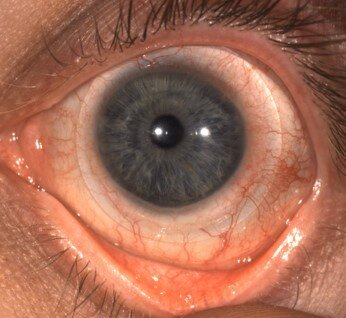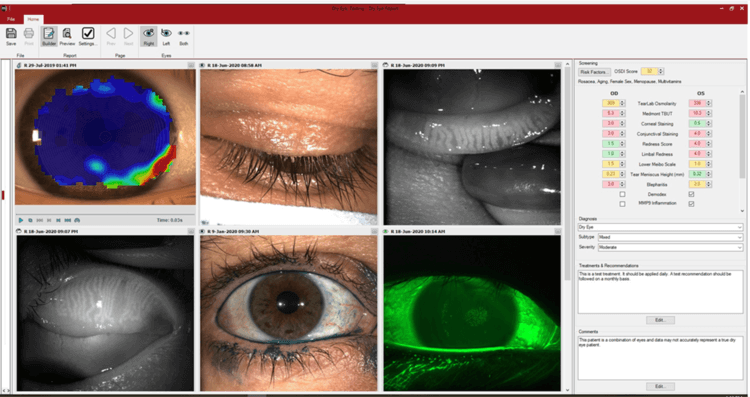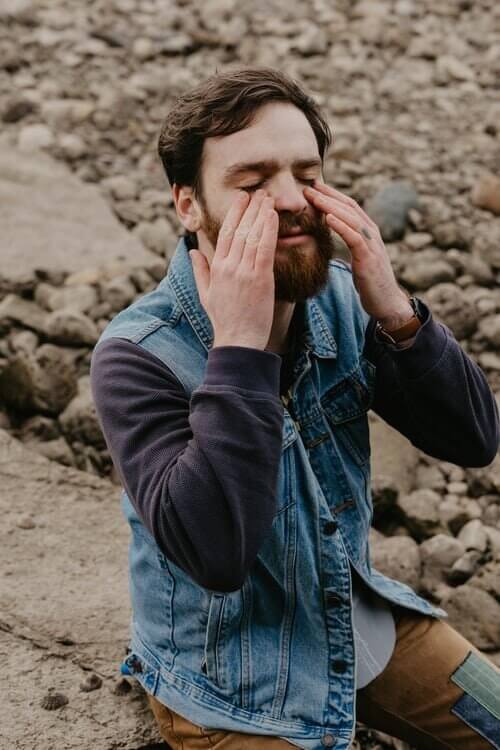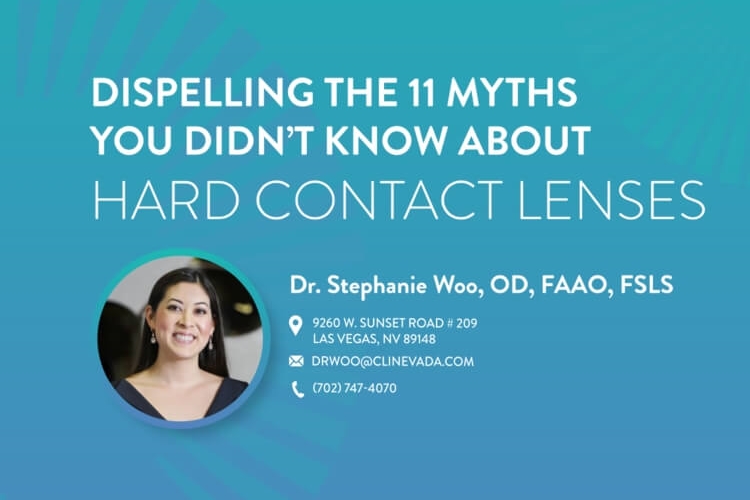What is dry eye?
Dry eye is a common chronic disease that results from an unhealthy tear film. The tear film covers the surface of your eye called the cornea to keep it protected, lubricated, and smooth. Tears are important in maintaining a smooth and clear front surface of your eye which provides clear and comfortable vision. Additional functions of the tear film include reducing the risk of eye infection and washing away unwanted material from the eye.The tear film can be divided into three layers that contain a mix of oils, water, mucous, and antibodies. Damage to any of these layers would result in dry eyes. In some cases, the tear film can become inadequate by simply not producing enough tears which leaves the cornea exposed to the environment. In other cases, enough tears are produced but fails to remain on the surface of eyewhich affects the overall tear quality. Both instances may result in inflammation and damage. This commonly results in blurry vision between blinks and a gritty sandy feeling. Luckily, there are several options for treatment that improve sensation and vision for each patient.

Causes of dry eye
Although dry eye is a relatively common condition, there are many different causes. A non exhaustive list of causes include: normal aging, systemic autoimmune disease, medication use, allergies, contact lens use, and previous eye surgery. These can result in either a decrease in production of tears or an increase in tear evaporation (loss of tears). Tear production can be affected by normalaging when the glands that produce tears naturally slow down. Dry eyes tend to be more common in people over 50 for this reason. Some medical conditions such as Sjogrens, Vitamin A deficiency, and rheumatoid arthritis may decrease tear production as part of its disease process. Medications such as antihistamines, antipsychotics, antidepressants, decongestants, hormone replacement, and birth control can have similar effects on production. Oral contraceptives and other hormonal changes from pregnancy and menopause also place women at higher risk for dry eye. Your bodyproduces tears as a result of feedback from your cornea (front of eye) and any disruption to this surface can result in less tears made. Some examples of this would include long term use of contact lenses and refractive eye surgeries such as LASIK. Anatomical problems that don’t allow your eyelids to close all the way could result in dry eye as well. Whatever the cause, a comprehensive eye exam with the addition of newer technology allows eye doctors to accurately diagnose and treat dry eye disease.
Symptoms of dry eye
When your tear film inadequately covers the cornea, it results in several symptoms. Some common complaints include:
- Gritty, sandy sensation in your eyes
- Feelings of something being in your eye
- Blurred vision that comes and goes with blinking
- Watery eyes
- Difficulty wearing contact lenses for extended periods of time
- Stringy mucous discharge
- Redness
- Light sensitivity
Dry eye presents to different degrees in each person. It is a chronic and progressive condition that will not improve unless action is taken. If you have been diagnosed with dry eye, seek remedies to improve quality of life and prevent further complications.


Preventing dry eye
- Take breaks during long tasks
- 20-20-20 rule.
- Every 20 minutes take a 20 second break and look 20 feet away.
- Use of artificial tears regularly
- If using artificial tears more than four times per day, consider use of a preservative free artificial drop.
- Use humidifiers at home to add moisture to dry air
- Protect your eyes in windy or harsh environments with sunglasses
- Avoid cigarette smoke
- Improve overall eyelid hygiene-- including regular washes with a clean washcloth as well as warm compresses to help release oil from your eyelids’ glands.
- Blink regularly
- Taking nutritional supplements that contain essential fatty acids
- Avoid dehydration by consuming 8-10 glasses of water each day
- Switch to daily disposable contact lenses and reduce daily wear time
Treating dry eye
Treatments for dry eye target restoring normal tear quality and amount as well as minimizing discomfort. The most common treatment for dry eye is artificial tears which can be found over the counter at your local drug store. However, if you feel that you need additional treatment, some options include:
Restasis
If over the counter artificial tears aren’t cutting it, an eye doctor may recommend a prescription eye drop called Restasis. In addition to providing lubrication to the eye, it acts to reduce inflammation and encourages natural production of tears. However, Restasis takes a minimum of 90 days to observe the full treatment effect.
Xiidra
An alternative prescription drop is Xiidra. It acts in a similar manner to Restasis to reduce inflammation and improve lubrication of the eye surface.
Punctual plugs
Your eye doctor can place plugs into the drainage system of your eye to keep your tears on the surface of your eye for a longer time. The plugs are placed in the inner corners of the upper and lower eyelids to prevent tear drainage. This helps reduce symptoms of dry eye by allowing more tears to remain on the cornea at once. The tears will simply evaporate off the surface instead of draining out. Your doctor may use temporary short collagen plugs that dissolve on their own or more long-term plugs that require removal.
Meibomian gland expression
If your dry eyes are caused by increased evaporation, it is typically due to an inadequate amount of oil in your tears. This oil is normally secreted by glands on your eyelids. These glands are called meibomian glands and can become clogged. An in-office procedure is available to squeeze the clogged glands to allow for free flow of oil.
Warm compress
Warm compresses can be used in addition to meibomian gland expression or as an alternative. Warm compresses applied to closed eyelids twice a day may help soften oil glands and allow for better flow.
LipiFlow
LipiFlow is anin-office treatment that provides a heat massage to the eyelids. This works to reduce clogged glands, similar to meibomian gland expression and warm compress.
Intense pulsed light (IPL)
IPL has been previously used in dermatology practices for acne and other skin conditions. When this is used on skin, it works to close up abnormal blood vessels that would cause inflammation. This allows the glands on the eyelids to function properly. In addition, the heat provided by the light melts the oils in clogged glands allowing for easy release.

Scleral lenses for dry eye
An option to provide relief for dry eye patients is the use of scleral contact lenses. Soft contact lenses sit right on the cornea and can cause irritation for dry eye patients. Scleral contact lenses sit on the white of the eye (the sclera) and vault over the cornea. This allows space between the contact lens and the surface of the cornea where a saline solution can rest. This solution acts as a constant source of hydration and thereby provides great symptom relief for dry eye patients. It can also act as a shield for the eye to prevent further damage and mechanical friction. Scleral lenses may help improve appearance of red irritated eyes by providing that source of hydration and protection for the eye. Scleral lenses are a great option for dry eye patients due to their relief from discomfort, simultaneous vision correction, and its protective nature.
Frequently asked questions about dry eye:
How can you know I have dry eye? How do you test for it?
Dry eye can be diagnosed in a comprehensive eye examination. Your eye doctor can perform a series of tests to determine if you have dry eye disease and even figure out what type of dry eye you have: decreased tear production or increased tear evaporation. This allows for the best targeted treatment since they can get right down to the source of the problem. In the exam, your eye doctor will assess the eyelids, quantity and quality of tears, and review your health history to help with the diagnosis. Special dyes can be placed on the eye to observe tear composition and emphasize any abnormal changes in tear film or eyelid structures.
Does dry eye worsen over time?
Without proper treatment and attention, dry eye symptoms may worsen over time. Depending on the cause of the condition, it may not be completely curable. However, there are multiple options for treatment that an eye doctor can go over with you to improve your condition.
Will dry eye ever completely go away?
Dry eye disease is a chronic condition; however, your doctor can work with you to maintain a good quality of life by managing your comfort and preventing visual problems.
What can happen if I let my dry eye go untreated?
Due to the protective nature of the tear film, dry eye may result in eye infections, damage to the cornea, and decreased quality of life. With the presence of severe dry eyes, corneal ulcers or vision loss may occur. It may also make it difficult to go about your everyday life, includingtrouble with prolonged reading or outdoor activities.
Why do my eyes water so much if I have “dry eye”?
Don’t be fooled--this is the confusing part of the condition! These tears are referred to as reflex tears. This means that the irritation from dry eyes causes extra tears to release. However, these new tears are made primarily of water, so they don’t include all the things normally found in the tear film. Its produced just to wash away irritants. This means that the normal functions of the tear film such as lubrication and protection of the cornea still cannot be done.

A special dry eye patient was seen who had given up hope for her eyes. Read more about her case and how we helped her!

